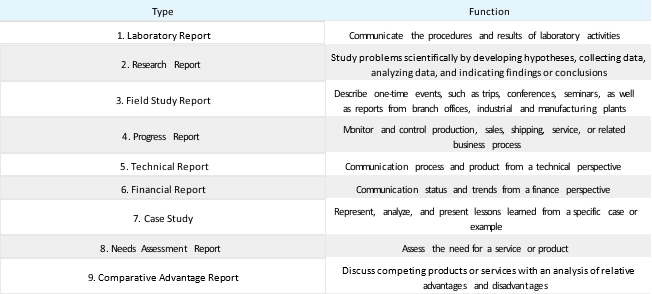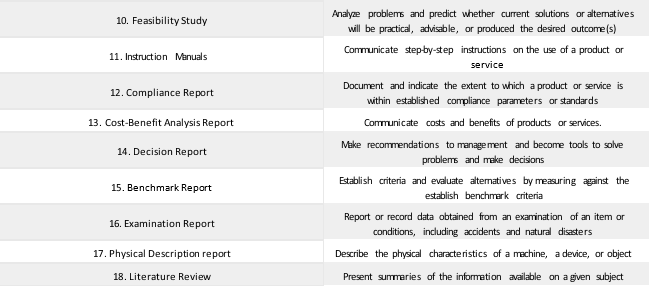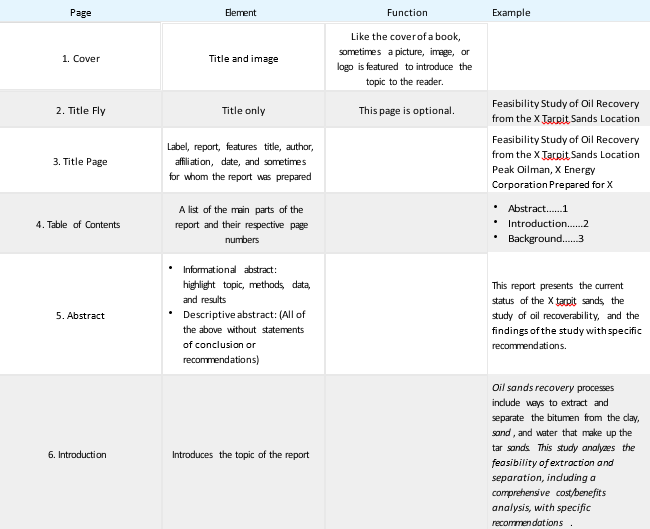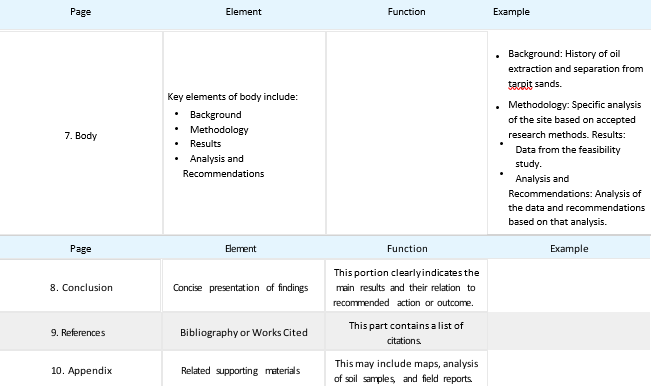Learning Objectives
Discuss the main parts of a report.
Understand the different types of reports.
Write a basic report.
What Is a Report?
Reports are documents designed to record and convey information to the reader. Reports are part of any business or organization; from credit reports to police reports, they serve to document specific information for specific audiences, goals, or functions. The type of report is often identified by its primary purpose or function, such as an accident report, a laboratory report, a sales report, or even a book report. Reports are often analytical or involve the rational analysis of information. Sometimes, they simply “report the facts” with no analysis at all but still need to communicate the information clearly and concisely. Other reports summarize past events, present current data, and forecast future trends. While a report may have conclusions, propositions, or even a call to action, demonstrating the analysis is the primary function. A sales report, for example, is not designed to make an individual sale. It is, however, supposed to report sales to date and may forecast future sales based on previous trends. This chapter is designed to introduce you to the basics of report writing.
Types of Reports
Reports come in all sizes but are typically longer than a page and somewhat shorter than a book. The type of report depends on its function. The function of the report is its essential purpose, often indicated in the thesis or purpose statement. The function will also influence the types of visual content or visual aids, representing words, numbers, and their relationships to the central purpose in graphic, representational ways that are easy for the reader to understand. The function may also contribute to parameters like report length (page or word count), word choice, and readability. “Focusing on the content of your longer business documents is not only natural but necessary because doing so helps ensure complete, correct information” (Bovee, C., and Thill, J., 2010).
Reports vary by function, and they also vary by style and tradition. Within your organization, employer-specific expectations may need to be addressed to meet audience expectations. This chapter discusses reports in general terms, focusing on common elements and points of distinction, but reference to similar documents where you work or additional examination of specific sample reports may serve you well as you prepare your own report.
Informational or Analytical Report?
There are two main categories for reports, regardless of their specific function or type. An informational report informs, instructs, and presents details of events, activities, individuals, or conditions without analysis. An example of this type of “just the facts” report is a police accident report. The report will note the time, date, place, contributing factors like weather, and identification information for the drivers involved in an automobile accident. It does not establish fault or include judgmental statements. You should not see “Driver was falling down drunk” in a police accident report. Instead, you would see “Driver failed sobriety tests and breathalyzer and was transported to the station for a blood sample.” The police officer is not a trained medical doctor and is therefore not licensed to make definitive diagnoses, but can collect and present relevant information that may contribute to that diagnosis.
The second type of report is called an analytical report. An analytical report presents information with a comprehensive analysis to solve problems, demonstrate relationships, or make recommendations. An example of this report may be a field report by a Center for Disease Control (CDC) physician from the site of an outbreak of the H1N1 virus, noting symptoms, disease progression, steps taken to arrest the spread of the disease, and to make recommendations on the treatment and quarantine of subjects.
Table 9.4.1 includes common reports that may be informational or analytical depending on the audience’s needs.


How Are Reports Organized?
Reports vary by size, format, and function. You must be flexible and adjust to the audience’s needs while respecting customs and guidelines. Reports are typically organized around six key elements:
- Whom the report is about and/or prepared for
- What was done, what problems were addressed, and the results, including conclusions and/or recommendations
- Where the subject studied occurred
- When the subject studied occurred
- Why the report was written (function), including under what authority, for what reason, or by whose request
- How the subject operated, functioned or was used
Consider these essential elements when considering your stakeholders or those interested in the report. That may include the person(s) the report is about, whom it is for, and the larger audience of the business, organization, or industry. Ask yourself who the key decision makers are, who will read your report, who the experts or technicians will be, and how executives and workers may interpret your words and images. While there is no universal format for a report, the information has a common order. Each element supports the main purpose or function in its own way, playing an important role in the representation and transmission of information.


Here is a checklist for ensuring that a report fulfills its goals.
- The report considers the audience’s needs
- The format follows the function of the report
- The format reflects institutional norms and expectations
- Information is accurate, complete, and documented
- Information is easy to read
- Terms are clearly defined
- Figures, tables, and art support written content
- Figures, tables, and art are clear and correctly labeled
- Figures, tables, and art are easily understood without text support
- Words are easy to read (font, arrangement, organization)
- Results are clear and concise
- Recommendations are reasonable and well-supported
- The report represents your best effort
- The report speaks for itself without your clarification or explanation
Key Takeaway
Informational and analytical reports require organization and a clear purpose.
Exercises
Find an annual report for a business you want to learn more about. Review it with the previous reading in mind and provide examples. Share and compare with classmates.
Write a report on a trend in business that you’ve observed, and highlight at least the main finding. For example, from the rising cost of textbooks to the online approach to course content, textbooks are a significant issue for students. Draw from your experience as you bring together sources of information to illustrate a trend. Share and compare with classmates.
Bovee, C., & Thill, J. (2010). Business communication essentials: A skills-based approach to vital business English (4th ed.). Upper Saddle River, NJ: Prentice Hall.
This page titled 9.4: Report is shared under a CC BY-NC-SA 3.0 license and was authored, remixed, and/or curated by Anonymous (LibreTexts Staff), from which source content was edited to the style and standards of the Pressbook platform licensed under a Creative Commons Attribution-NonCommercial-ShareAlike 4.0 International License by Brandi Schur.

